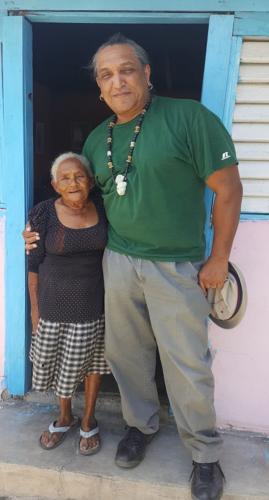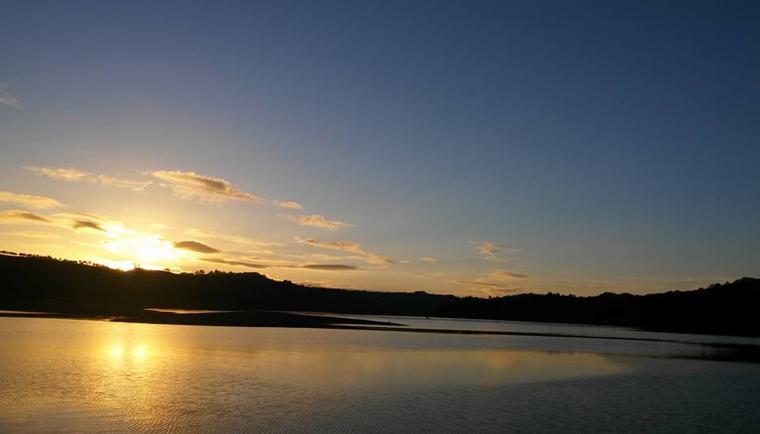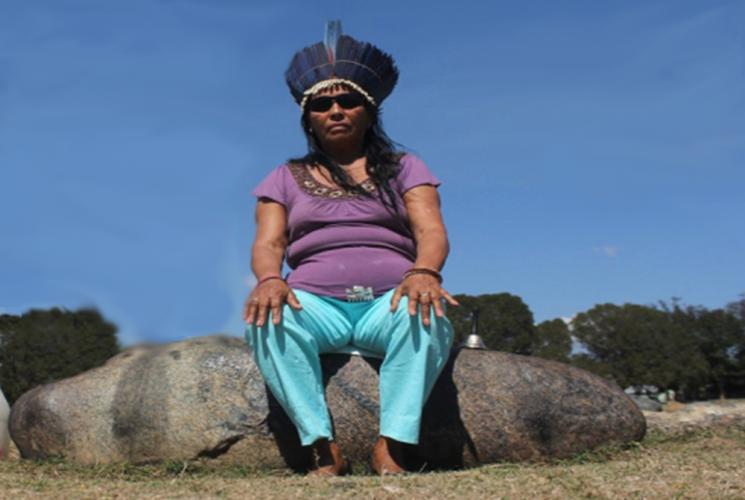As part of a research trip for the Caribbean Indigenous Legacies Project, my good friend and island guide Milton Sanchez Velasquez and I drove through a baguada (fierce rain storm) in Kiskeya (Dominican Republic), from the Maguana region in the western provinces towards the east, where the international airport is located. We headed there to pick up Dr. José Barreiro, scholar emeritus of the National Museum of the American Indian, who was arriving that afternoon. I was suffering from chronic back pain that was especially bad that day. Milton, concerned for me, suggested perhaps he should drive. The intense look of pain on my face must have been quite evident. I reminded him that the car was rented in my name; therefore, I just had to bear it. By that point, I had become fed up with pain pills, patches and the like. Nothing seemed to help.
As we approached the town of Bani, Milton recommended we visit a healer named Doña Yoya who was skilled in soba or sobar, a type of massage. This particular ritual is also common among the Lokono Arawak and other Indians of northern South America where the ancestors of the Taíno originated. They too call it soba. The rain and clouds made the morning seem as if we were driving in the twilight. Finally, the sky cleared for a moment as we arrived at her home, a small shack by the side of the road surrounded by mountains and hills. It felt quite eerie to me.
We knocked on the door a few times. Suddenly the door opened slowly and a small, frail woman – standing around three feet, eleven inches tall – looked up at us from her doorway, with sparkling eyes and a huge smile. She greeted us by saying, “Welcome to my humble home. All that I have is yours.” Her tone was disarming, so remarkably friendly! I instantly felt like I was home. This graciousness was amazing, but not unique. Nearly all rural people of Kiskeya are similarly friendly and generous. I immediately explained my ailment to her and remarked that the rain seemed to aggravate my pain. She listened intently, smiled warmly and with a simple nod agreed to help me. Milton had cautioned me, however, “You can give her money, but do not ask her how much she charges. That is very disrespectful.”
She asked me to take off my shirt. I imagined she was about to introduce me to some unknown native plants or herbs. However, I am quickly disillusioned when instead she pulled out a jar of Vicks VapoRub! My disappointment did not last long though. She scooped up a heaping amount, joked about the size of my back and began to massage me. Suddenly she began drawing intricate, indiscernible, geometric patterns with her thumbnails on my back while singing in a low murmur. She began on my neck, going down to the small of my back, praying under her breath, swaying her body back and forth rhythmically. When the design was complete, she lit a cigar and blew the smoke over my entire back. Making a loose fist, she placed it over the affected area and sucked in air as if to dislodge whatever was stuck there. She then spit it out forcefully.
“In a few days your pain will go,” she said. “It may return to another area, but it will never hurt you there again.” I was grateful and extremely curious. I asked her, how, when and where did she learn to heal in this way? “When I was a young girl,” she began, “I met an Indian man on that mountain you see there [pointing with her lips across the street]. Every day, I’d walk up the mountain to meet him, and he’d teach all he knew of plant medicine. But one day he did not return…I never saw him again. I have been a healer ever since.”
Stories like this persist all over Kiskeya, despite the extinction paradigm that is prevalent here and the major islands of the Caribbean. Indigenous healing customs and traditions form part of a highly complex and mostly – since the Conquest Era beginning in 1492 – hidden legacy. Its roots, however, existed for thousands of years before Spanish arrival. Existing both on its own and in syncretic form, they are known as Agua Dulce (Sweet Water) and by some as Tamani.
San Juan de la Maguana is located on the island’s southwest. Main roads were not built until the 1930s. Isolated, difficult to reach frontier land harbored maroons, of both Taíno Indian and African extraction up to fairly recent times. Cultural and spiritual syncretism came to epitomize this region. In one tradition, for example, the Liboristas follow the teachings of the island’s only Messianic figure, Papa Liborio, a healer and rebel who fought and was killed by American occupying forces in 1922. Another tradition is known as the 21 Divisions, a tradition that is sometimes referred to as Dominican Vodún.
Both traditions have many followers island-wide, and both have strong African, Catholic and Taíno influences.1 The Indigenous aspects of these religions are known as Sweet Water, the Red Band or Blue Water. The Indian traditions play a minor role in 21 Divisions, but play a much larger role among the Liboristas. Peculiar to Liboristas is the fact that their altars contain a heavy Catholic influence and a minor African one, and choose to keep all Indian iconographies away from anything European or African. In fact, these altars, called buyio, are usually kept deep within caves. Tobacco, casabe (a traditional Taíno bread), water, unusual stones and native fruits are part of the offerings in this tradition. Devotion to ancient deities, historical Indian cacike (chiefs), both male and female, suggests strong ancestor worship.
Carmen Popa, a Liborista practitioner, explains: “Here at the mission (church), we believe that the Father, the Son, the Holy Ghost, and the spirit of our Cacike Anacaona [an historical female Taíno Indian chief] shines light on our path.” When asked if she has Indian ancestry, she says shyly, “My father always said we come from Indians, but it is hard to say such things here.” Of course, she was referring to the stigma that surrounds any notion of being Taíno or Indigenous.
I thought about this. It reminded me of my own life, wherein I always knew of my Taíno descent, but openly acknowledging it was discouraged. In fact, I often did, only to be ridiculed by friends, classmates and teachers alike. Like Carmen, often times I would just sit quietly and patiently while others determined for me, with whom or what I’m supposed to identify. Times have changed, however, and exciting new research is demonstrating that the Taíno, although assimilated, were never exterminated. In fact, a study was published in February 2018 based on the sequencing of ancient DNA from a 1,000-year-old tooth from the Bahamas. It conclusively proved that modern day Caribbean people not only have strong Native ancestry but also that it is decisively Taíno, and not from imported Native slaves, as has been suggested by some historians.2 Compiled by an international team of researchers, the study findings are published in the journal Proceedings of the National Academy of Sciences (PNAS).
Here in Maguana, the people not only embrace a spiritual tradition full of Native customs and iconographies, which form the core of their spirituality, but also maintain an identity. This is, indeed, hiding in plain sight. One woman, Margarita Acevedo, said, “Although I practice 21 Divisions, my Indian Division [sect] comes from my mother’s town of Jacagua.” The people in her town only adhere to Agua Dulce. Their buyio (altars) are pure Tamani. Nothing Catholic nor African are allowed on these altars. Acevedo confirmed for me the fact that Agua Dulce is practiced separately from the other two religions.
Indeed, one of the benchmarks of Agua Dulce is that even when it is practiced in syncretism, the Indian portion insists on being set apart. If one is lucky enough to meet someone practicing solely Indian devotion – which also means devotion to land, native spirits and the old Indian gods and historical figures – they will readily explain that the Indian refuses to share space with the other two customs as these work with blood and metal. One important factor is that all Agua Dulce altars contain certain elements, the most important of which are tobacco, casabe, water and stone.
During the 1920s and ’30s, many skirmishes took place in this region between campesinos (rural people) and the rich land barons, most of whom had “elite status,” meaning of Spanish descent. They followed the racist views of Rafael Leonidas Trujillo (Dominican President/Dictator from 1930-1961), who declared that Haitians and their “evil” voodoo religion had infiltrated the border towns of the island. Thus all beliefs from this area were deemed African, Black, Haitian – and evil. Add the extinction model to this brainwashing and it is no wonder why few, if any, historians have ever researched the Indigenous Taíno beliefs that persist in the area. In the complicated racial politics of the Dominican Republic, Dominicans often use indio as a preferred label over black, and to differentiate themselves from Haitians. All of this while actual Indian descent people and Indian customs continue to be ignored and submerged under the extinction model.
As I looked across the valley of San Juan de la Maguana, I was reminded of a quote by Jan Lundius, a religious historian from Sweden who has studied Maguana, its people and their religions for many years. He writes: “I wish to indicate that many inhabitants of the island of Hispaniola find themselves within an entirely different universe than the one I am used to, and it is often through their way of telling stories that they are able to slightly open up the door to that amazing world. Myths, legends and rituals animate their world, and if you are fortunate enough, you may catch a glimpse of how that ‘other’ world might appear.”
With the exhibition, Taíno: Native Heritage and Identity in the Caribbean, now open at the Museum in New York, and with the advent of the latest ancient DNA sequencing studies – which conclusively demonstrate that Native DNA is not only present but abounds in the Caribbean and is of Taíno extraction – perhaps in-depth research will finally be conducted throughout the Caribbean region.
Our complete Taíno story is yet to be written, but I’ve had my own numerous, fascinating, glimpses of it. And my back pain never returned.
To learn more, join the Museum for the upcoming “Taíno: A Symposium in Conversation with the Movement,” on Saturday, September 8, 2018 from 10:45 a.m. to 5:30 p.m. EST. Log onto the live webcast: AmericanIndian.si.edu/multimedia/webcasts or attend in person (seating is available on first-come, first-served.)
Experts representing Indigenous studies, genetic science, anthropology, linguistics, and other academic disciplines will explore exhibition themes in dialogue with Taíno/Indigenous Caribbean community leaders and cultural workers. Scholars featured in this issue, including Christina González, Jorge Estevez, and Dr. Hannes Schroeder, are among the presenters. Director Kevin Gover will offer a welcome.
Cosponsored by the Smithsonian’s National Museum of the American Indian and the Smithsonian Latino Center
Sadly on June 13, 2018, Doña Yoya crossed over. Like Yoya there are many healers on the island, most of them in their 80s or 90s. In 10 years they will leave us, taking with them their healing traditions, customs and stories. Their stories must be recorded. It is for this reason I am leaving the job I love at the NMAI to return to my homeland and begin just that.
Dr. Lynne Guitar contributed to this article. Dr. Guitar is an historian and cultural anthropologist who has researched and written about the Taíno for the past 30 years, 20 of which were spent working in the Dominican Republic. She has published 11 books and contributed to many others, and has been featured in more than a dozen documentaries, including the BBC, History Channel and Discovery Channel.
1 Jan Lundius, The great power of God in San Juan Valley: Syncretism and messianism in the Dominican Republic, 1995.
2 Compiled by an international team of researchers, the study findings are published in the journal Proceedings of the National Academy of Sciences (PNAS). Hannes Schroeder, Center for GeoGenetics, Natural History Museum of Denmark, University of Copenhagen, and 26 co-authors, "Origins and genetic legacies of the Caribbean Taino," PNAS, vol. 115, no. 10, pp. 2341-2345, published on-line March 6, 2018, at pnas.org.



